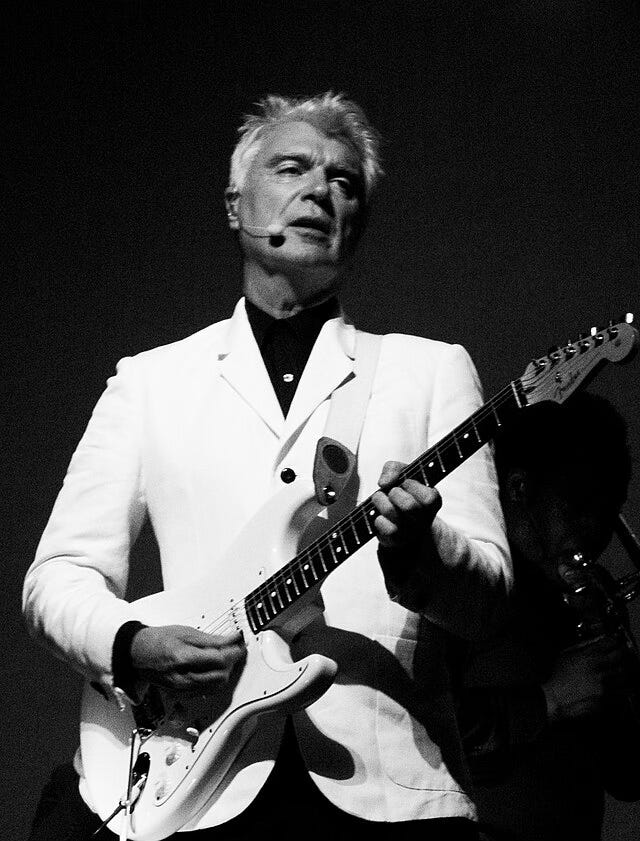
Few artists have weaponized nonsense as effectively as David Byrne.
Here’s the chorus of “The Great Curve,” the third track on Talking Heads’ Afro-tinged masterpiece Remain in Light. Good luck figuring out what this means:
Not to mention the Dada-infused ramblings of “I Zimbra”:
Anyone who's listened to Talking Heads will recognize how Byrne’s lyrics function like an instrument, riding the groove as an element of rhythm more than melody.
His influence endures. Many contemporary lyricists adopt similarly nonsensical stylings. “Yesterday I woke up sucking a lemon,” declares Thom Yorke in Radiohead’s “Everything in Its Right Place.” “I’ve come here to make a ceramic shoe,” exclaims Dry Cleaning’s Florence Shaw, who collects her lyrics from adverts, drawings and stray thoughts, then scatters them over her band’s jagged guitar licks and staccato rhythms.
So, why nonsense? What purpose does it serve?
Well, for one, these spiky little provocations can be surprisingly catchy. There is alpha in the unexpected. Chances are the “water flowing underground” refrain from Talking Heads’ “Once in a Lifetime” is burned somewhere into your memory.
But Byrne’s reasoning is a little more interesting than that. In How Music Works, he writes about his wariness of conventional lyrics, calling them a “dangerous addition” to music.
Why? Because lyrics can destroy a song’s “pleasant ambiguity,” the mystery that lets us bring something of our own to the music:
“Ambiguity allows listeners to psychologically tailor a song to suit their needs, sensibilities, and situations, but words can limit that, too.”
Byrne is hardly the first to suggest that ambiguity — the space between what’s given to us and what we take away — is the essence of art. We’ve all been told to “show not tell” in high school English class, to leave our readers’ imaginations room to roam. Nonsense, then, is this premise on steroids, leaving all interpretation up to the listener.
What makes Byrne’s approach doubly fascinating is that his lyrics balance literal nonsensicality with rhythmic, melodic, and emotional specificity.
To put it less pretentiously, they fit.
So, even though the following, from album opener “Born Under Punches,” sounds like nonsense:
“Take a look at these hands. The hands speak. The hands of a government man.”
In context it feels almost cosmically inevitable. It slams into the opening verse like a kick drum. You could replace it with something equally abstract, and it wouldn’t work.
Byrne walks us through his writing process, which begins by improvising melodies while singing nonsense syllables. Once he’s established the melody, he transcribes the recording, replacing the gibberish with actual words. If he’s overthinking it, he will “distract the gatekeepers” of his mind by jogging or cooking, or cycling, recording phrases that match the song’s meter as they occur to him, enabling the emergence of “surprises and weirdness from the depths.”
Throughout this process, he is seeking to find words that sound as close as possible to his original gibberish:
“I do that because the difference between an ohh and an aah and a B and a th sound is, I assume, integral to the emotion that the story wants to express. I want to stay true to that unconscious, inarticulate intention.”
Notice how Byrne acknowledges that the lyrics, while seemingly meaningless, serve a specific artistic purpose. It’s nonsense, yes, but it’s intentional nonsense. It’s nonsense as art, achieving an emotional truth that resonates beyond literal meaning.
And (this is the best part), the more space he gives to nonsense, the more what first appeared nonsensical suddenly…. makes sense:
“I found that, remarkably, solving the puzzle of making words and phrases fit existing structures often resulted, somewhat surprisingly, in words that have an emotional consistency and sometimes even a narrative thread, even though those aspects of the text weren’t planned ahead of time."
Byrne calls this “emergent storytelling.” Listeners of Infinite Loops may know it as complex adaptivity. Whatever you want to call it, if you’re feeling creatively restrained, perhaps the answer is to loosen up a bit — to embrace nonsense or, as the great man himself would put it, to Stop Making Sense.
If you enjoyed this, check out last week’s installment: The Creativity Diaries #4: Salvador Dalí



